 On Thursday, November 21st, OPIM Innovate hosted a rotational virtual reality (VR) and augmented reality (AR) workshop for UConn’s Management and Engineering for Manufacturing program (MEM). Here, students from Professor Mousumi Roy’s MEM3221 class were tasked with brainstorming ways in which either VR or AR can be integrated into the manufacturing process.
On Thursday, November 21st, OPIM Innovate hosted a rotational virtual reality (VR) and augmented reality (AR) workshop for UConn’s Management and Engineering for Manufacturing program (MEM). Here, students from Professor Mousumi Roy’s MEM3221 class were tasked with brainstorming ways in which either VR or AR can be integrated into the manufacturing process.
In order for OPIM Innovate to accommodate all participating MEM students, the same workshop was given three different times throughout mid-November. Stations were set up around the Innovate Lab to accommodate several people at once, featuring devices such as the Google Cardboard headset and the Oculus Go. The most popular of all virtual reality devices was the HTC Vive. This wired headset allowed students to participate in Valve’s The Lab, an immersive experience with various minigames showcasing the potential of VR.
After participating in all stations, students became more comfortable with VR and AR technology. This led to the insurgence of ideas for MEM applications and an enthusiasm for innovation. Daniel Castillo (MEM ‘19), for example, informed me that VR would be a great way to start training incoming manufacturing personnel. “It can teach us how to program and utilize on-site machinery,” he said. “Since we don’t all have access to these machines in schools, VR is a great alternative.”
Two other students, Nick Porebski (MEM ‘20) and Ben Zekowski (MEM ‘20), informed me of their ideas for VR applications in computer-aided design (CAD). “Students could view and interact with a draft of their design in real-time,” Nick said. “And, since you don’t have to print the material,” Ben added, “it could save on time and cut costs.”
We thank the MEM department for their interest in the OPIM Innovate initiative and to all the students who participated in this event! For any innovation inquiries, please feel free to consult the Lab, again!
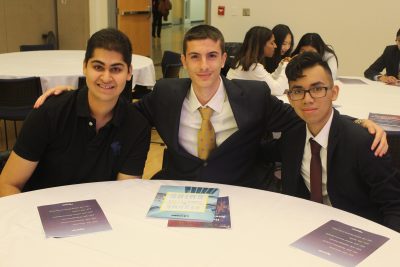 On Wednesday, November 20th, OPIM Innovate hosted the Hanover Image Analytics Challenge in partnership with Hanover Insurance Group. There, ten teams competed for the opportunity to implement their solutions in a real-world business setting through a spring semester externship. Cash prizes were split between four different thresholds, each having their own requirements. While the lowest threshold provided each participant with a baseline of $100, the highest threshold awarded each team member with $500 and an opportunity to work with Hanover. The objective of the challenge was to have participants make use of a dataset including details on current customer properties and prospective properties to be insured by Hanover.
On Wednesday, November 20th, OPIM Innovate hosted the Hanover Image Analytics Challenge in partnership with Hanover Insurance Group. There, ten teams competed for the opportunity to implement their solutions in a real-world business setting through a spring semester externship. Cash prizes were split between four different thresholds, each having their own requirements. While the lowest threshold provided each participant with a baseline of $100, the highest threshold awarded each team member with $500 and an opportunity to work with Hanover. The objective of the challenge was to have participants make use of a dataset including details on current customer properties and prospective properties to be insured by Hanover.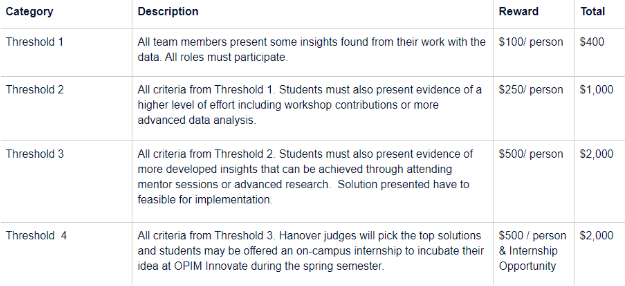
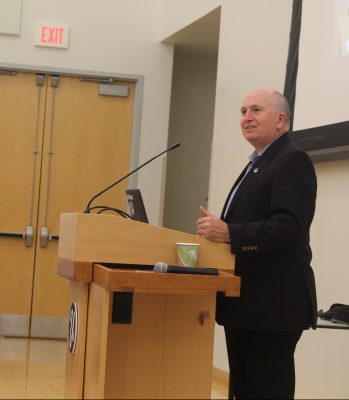 The difference between this challenge and other case competitions is that it implored students to search for interdisciplinary team members. Rather than having all participants be business majors or intra-major, there were a multitude of participants with little to no business or technical knowledge. As explained by Rob Brewer, Middle Market Vice President and Chief Underwriting Officer at Hanover, the required roles self-assigned by each team member–business analyst, marketing specialist, developer, and data analyst–reflected Hanover’s real-world teams. “Our employees seldom work by themselves,” Brewer said. “They’re always working together across roles.”
The difference between this challenge and other case competitions is that it implored students to search for interdisciplinary team members. Rather than having all participants be business majors or intra-major, there were a multitude of participants with little to no business or technical knowledge. As explained by Rob Brewer, Middle Market Vice President and Chief Underwriting Officer at Hanover, the required roles self-assigned by each team member–business analyst, marketing specialist, developer, and data analyst–reflected Hanover’s real-world teams. “Our employees seldom work by themselves,” Brewer said. “They’re always working together across roles.”  Vaughn Nangle, the data analyst of another Tier 3 group entitled
Vaughn Nangle, the data analyst of another Tier 3 group entitled  Raised in small-town East Granby, CT,
Raised in small-town East Granby, CT,  On Thursday, November 14th, OPIM Innovate hosted a Design Thinking workshop in partnership with the UConn American English Language Institute (UCAELI). During this workshop, students participating in the College Preparatory Experience program learned the first three steps of design thinking: define, empathize, and ideate. These steps implore students to define business objectives, understand the needs of their audience, and brainstorm potential ideas for a business solution. Tara Watrous, Innovate’s project coordinator, assisted students throughout the design thinking process by providing an overview of each step. She then provided the following prompt for students to answer in groups: “How can technology be utilized to enhance learning English as a second language?”
On Thursday, November 14th, OPIM Innovate hosted a Design Thinking workshop in partnership with the UConn American English Language Institute (UCAELI). During this workshop, students participating in the College Preparatory Experience program learned the first three steps of design thinking: define, empathize, and ideate. These steps implore students to define business objectives, understand the needs of their audience, and brainstorm potential ideas for a business solution. Tara Watrous, Innovate’s project coordinator, assisted students throughout the design thinking process by providing an overview of each step. She then provided the following prompt for students to answer in groups: “How can technology be utilized to enhance learning English as a second language?”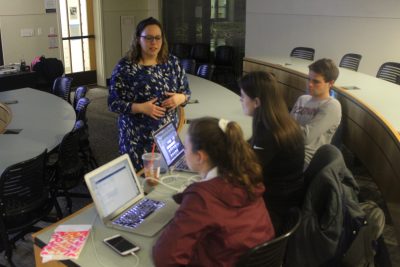 On Thursday, November 7th, Hanover Insurance and OPIM Innovate co-sponsored a Data Visualization workshop. Run by
On Thursday, November 7th, Hanover Insurance and OPIM Innovate co-sponsored a Data Visualization workshop. Run by 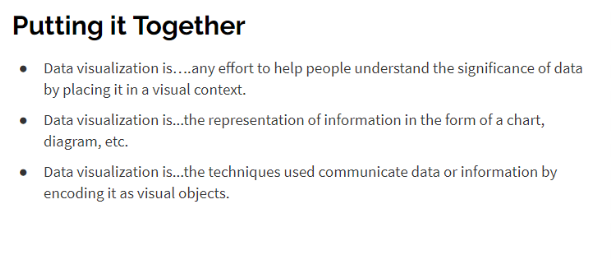
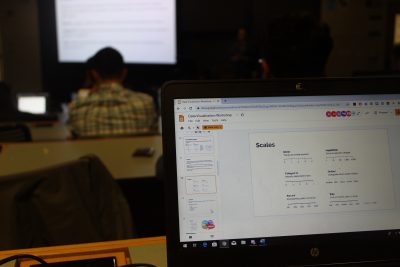 Of course, with any chart or visualization, there is always an intended purpose and audience in mind. For data visualization, artists can compare between data points, display parts of a whole, help users identify relationships, or even show the distribution of a dataset. What to do, however, depends on the needs of the audience, including what they may not know and what they could potentially get out of a certain visualization. For example, if someone wants to know the types of users that log onto a website, it wouldn’t be productive to create a visualization showing a distribution of total logins throughout the week.
Of course, with any chart or visualization, there is always an intended purpose and audience in mind. For data visualization, artists can compare between data points, display parts of a whole, help users identify relationships, or even show the distribution of a dataset. What to do, however, depends on the needs of the audience, including what they may not know and what they could potentially get out of a certain visualization. For example, if someone wants to know the types of users that log onto a website, it wouldn’t be productive to create a visualization showing a distribution of total logins throughout the week. 

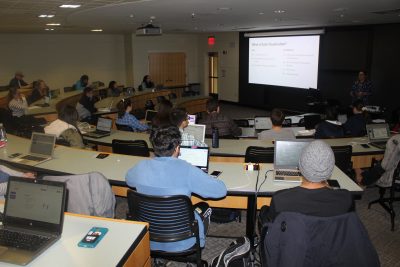 After the workshop, I approached Rossetti regarding her motivations for returning to UConn, not only as a guest lecturer, but also as an adjunct faculty member. Outside of this Data Visualization workshop, she teaches OPIM 3804: Data Visualization, open to all Management Information Systems (MIS) students and Data Analytics minors. “When I was a student at UConn,” she said. “I wasn’t sure in which direction I wanted to go in. I started as a Management major, finished all of my requirements, and then heard about the certificate in OPIM [the Data Analytics minor]. That led me into the world of analytics, a path I never imagined. Because I had that opportunity as a student, I was exposed to classes that were taught by adjunct faculty. There, I was able to see what they were doing in the real world, and what tools they were using. I knew from the moment I met one of my teachers [adjunct
After the workshop, I approached Rossetti regarding her motivations for returning to UConn, not only as a guest lecturer, but also as an adjunct faculty member. Outside of this Data Visualization workshop, she teaches OPIM 3804: Data Visualization, open to all Management Information Systems (MIS) students and Data Analytics minors. “When I was a student at UConn,” she said. “I wasn’t sure in which direction I wanted to go in. I started as a Management major, finished all of my requirements, and then heard about the certificate in OPIM [the Data Analytics minor]. That led me into the world of analytics, a path I never imagined. Because I had that opportunity as a student, I was exposed to classes that were taught by adjunct faculty. There, I was able to see what they were doing in the real world, and what tools they were using. I knew from the moment I met one of my teachers [adjunct 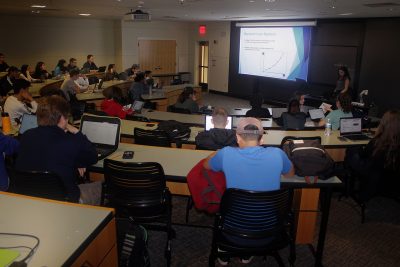 On Thursday, October 31st, Hanover Insurance and OPIM Innovate co-sponsored a Predictive Analytics workshop. Run by alumni and Travelers Data Integrity Specialist
On Thursday, October 31st, Hanover Insurance and OPIM Innovate co-sponsored a Predictive Analytics workshop. Run by alumni and Travelers Data Integrity Specialist 



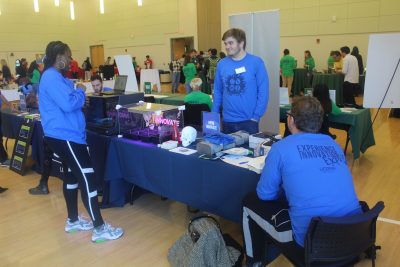 On Monday, October 21st, UConn held its annual Experience Innovation Expo in the Student Union Ballroom. There, OPIM Innovate Lab Specialists
On Monday, October 21st, UConn held its annual Experience Innovation Expo in the Student Union Ballroom. There, OPIM Innovate Lab Specialists 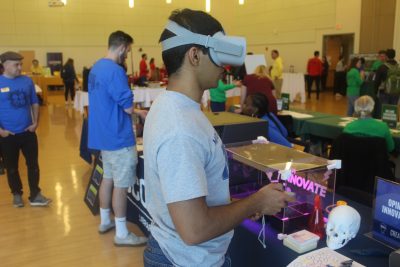 Udler, a wearable technology expert, also networked with the Puppet Arts department during the Innovation Expo. Having experienced working on
Udler, a wearable technology expert, also networked with the Puppet Arts department during the Innovation Expo. Having experienced working on